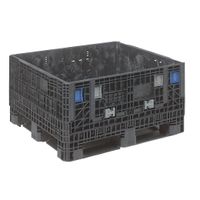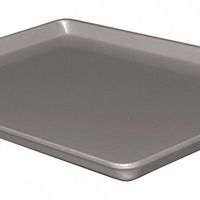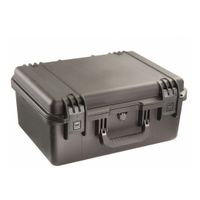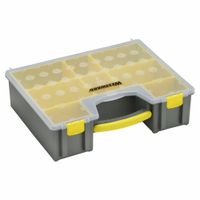Call +(254) 703 030 000 / 751 483 999 / 721 704 777
- Home
- Material Handling
- Storage Workspace
- Storage Containers
.....Read More
Frequently Asked Questions
What are the best storage containers for organizing a garage?
The best storage containers for organizing a garage are those that maximize space, provide durability, and offer easy access. Here are some top options:
1. **Clear Plastic Bins**: These are ideal for visibility and durability. Opt for stackable bins with secure lids to protect contents from dust and moisture. Label each bin for easy identification.
2. **Heavy-Duty Shelving Units**: Metal or high-strength plastic shelving units can hold large, heavy items. Adjustable shelves allow customization based on storage needs.
3. **Wall-Mounted Storage**: Pegboards, slat walls, and wall hooks are excellent for hanging tools, bikes, and other equipment, freeing up floor space.
4. **Overhead Storage Racks**: Utilize ceiling space with overhead racks for storing seasonal items or rarely used equipment. Ensure they are securely installed to handle weight.
5. **Tool Chests and Cabinets**: For organizing tools, a rolling tool chest or cabinet with drawers is perfect. Look for lockable options for added security.
6. **Modular Storage Systems**: These systems offer flexibility with interchangeable components like bins, shelves, and hooks, allowing for a tailored storage solution.
7. **Lockable Storage Cabinets**: For hazardous materials or valuable items, lockable cabinets provide security and organization.
8. **Storage Totes with Wheels**: For heavy or frequently moved items, wheeled totes offer convenience and ease of transport.
9. **Recycling and Trash Bins**: Designate specific bins for recycling and trash to maintain cleanliness and organization.
10. **Magnetic Strips and Bars**: Ideal for small metal tools, these strips can be mounted on walls for easy access and organization.
Choose containers based on the specific items you need to store, the available space, and your budget to create an efficient and organized garage.
How do I choose the right size storage container for my needs?
To choose the right size storage container, first assess the volume and type of items you need to store. Begin by categorizing items by size, weight, and fragility. Measure the dimensions of larger items and estimate the total volume of smaller items. Consider the frequency of access; frequently used items may require a more accessible container size.
Next, evaluate the storage location. Measure the available space to ensure the container fits comfortably, allowing for easy access and movement. Consider environmental factors like temperature and humidity, which may affect the material choice of the container.
Determine the purpose of storage. For moving, a larger container may be necessary to minimize trips. For long-term storage, a smaller, more organized container might suffice. Consider stackability if space is limited.
Research container types. Plastic bins are versatile and durable, ideal for most household items. Cardboard boxes are cost-effective for short-term use. Specialty containers, like those with airtight seals, are suitable for sensitive items.
Calculate the required number of containers. Divide the total volume of items by the volume of a single container to estimate how many you need. Opt for a slightly larger size if unsure, to accommodate future needs.
Finally, consider budget constraints. Balance cost with quality and durability. Investing in a slightly larger or higher-quality container can prevent future expenses related to damage or additional storage needs.
By systematically evaluating your storage requirements, location, and budget, you can select the most appropriate container size for your needs.
What materials are storage containers made from, and which is the most durable?
Storage containers are made from a variety of materials, each offering different levels of durability, cost, and suitability for specific uses:
1. **Plastic**: Commonly used due to its lightweight nature and affordability. Types include polyethylene, polypropylene, and polycarbonate. Polycarbonate is the most durable among plastics, offering resistance to impact and temperature variations.
2. **Metal**: Includes steel, aluminum, and tin. Steel, particularly stainless steel, is highly durable, resistant to corrosion, and can withstand heavy loads, making it ideal for industrial and long-term storage.
3. **Glass**: Offers excellent durability against chemical reactions and is non-porous, making it ideal for food storage. However, it is prone to breaking upon impact.
4. **Wood**: Used for decorative or rustic storage solutions. While aesthetically pleasing, wood is less durable against moisture and pests unless treated.
5. **Fabric**: Includes canvas and polyester. These are lightweight and flexible but less durable against physical damage and moisture.
6. **Composite Materials**: Combines materials like fiberglass and resin to enhance durability and resistance to environmental factors.
Among these, **metal**, specifically stainless steel, is considered the most durable material for storage containers. It offers superior strength, resistance to corrosion, and longevity, making it suitable for both industrial and domestic use. However, the choice of material ultimately depends on the specific requirements, such as the type of items being stored, environmental conditions, and budget constraints.
How do I properly clean and maintain storage containers?
To properly clean and maintain storage containers, follow these steps:
1. **Empty and Rinse**: Remove all contents and rinse the container with warm water to eliminate loose debris.
2. **Wash with Soap**: Use a mild dish soap and a non-abrasive sponge or cloth to scrub the container inside and out. Pay special attention to corners and crevices where residue can accumulate.
3. **Tackle Stains and Odors**: For stubborn stains or odors, create a paste with baking soda and water, apply it to the affected areas, and let it sit for 15-30 minutes before scrubbing. Alternatively, fill the container with a mixture of vinegar and water, let it soak, then rinse thoroughly.
4. **Rinse Thoroughly**: Ensure all soap and cleaning agents are completely rinsed off to prevent any residue from affecting future contents.
5. **Dry Completely**: Air-dry the containers upside down on a drying rack or use a clean towel to dry them. Ensure they are completely dry to prevent mold and mildew growth.
6. **Inspect and Repair**: Regularly check for cracks, warping, or damage. Replace containers that are compromised to ensure they remain airtight and safe for storage.
7. **Store Properly**: Store containers with lids off or loosely placed to allow air circulation. Stack them neatly to prevent warping and save space.
8. **Avoid Harsh Chemicals**: Do not use bleach or abrasive cleaners, as they can damage the material and leave harmful residues.
9. **Regular Maintenance**: Clean containers after each use and periodically even if not in use to maintain hygiene and prevent odors.
10. **Label and Organize**: Use labels to identify contents and dates, ensuring proper rotation and usage of stored items.
By following these steps, you can ensure your storage containers remain clean, odor-free, and in good condition for long-term use.
What are the differences between bins, totes, and storage boxes?
Bins, totes, and storage boxes are all used for organizing and storing items, but they differ in design, material, and purpose.
**Bins**: Bins are typically open-top containers used for easy access and quick retrieval of items. They are often stackable and come in various sizes and materials, such as plastic or metal. Bins are commonly used in warehouses, workshops, and retail environments for sorting and storing bulk items or components. Their open design allows for visibility and accessibility, making them ideal for frequently accessed items.
**Totes**: Totes are versatile containers with handles, designed for easy transport. They usually have a lid or cover, providing protection from dust and moisture. Totes are often made from durable plastic, making them suitable for both storage and transportation. They are used in various settings, including industrial, commercial, and personal environments, for organizing and moving items. Totes can be stackable and are often used in logistics and supply chain operations for efficient handling and distribution.
**Storage Boxes**: Storage boxes are enclosed containers with lids, designed for long-term storage and protection of items. They come in various materials, such as plastic, cardboard, or wood, and are available in different sizes. Storage boxes are used in homes, offices, and warehouses to store items that are not frequently accessed. They provide protection from dust, moisture, and pests, making them ideal for archiving documents, storing seasonal items, or organizing personal belongings.
In summary, bins are open and accessible, totes are portable with handles, and storage boxes are enclosed for protection. Each serves a distinct purpose based on accessibility, portability, and protection needs.
How can I maximize space using storage containers in a small apartment?
To maximize space in a small apartment using storage containers, start by assessing your needs and categorizing items. Use clear, stackable containers to easily identify contents and maximize vertical space. Opt for multi-functional furniture with built-in storage, like ottomans or beds with drawers. Utilize under-bed storage containers for seasonal items or linens.
In closets, employ hanging organizers and shelf dividers to optimize space. Use vacuum-sealed bags for bulky items like winter coats or bedding to reduce volume. Install wall-mounted shelves or pegboards in kitchens and bathrooms to keep surfaces clear.
For small items, use drawer organizers or small bins to prevent clutter. Label containers for easy access and organization. Consider using over-the-door organizers for shoes, accessories, or cleaning supplies.
In living areas, use decorative baskets or bins to store items like blankets or magazines, keeping them accessible yet tidy. For electronics, use cable management boxes to reduce visual clutter.
Maximize cabinet space with stackable or pull-out organizers, and use tension rods to create additional hanging space for cleaning supplies or kitchen tools.
Finally, regularly declutter to ensure you’re only storing necessary items, making the most of your available space.
Are there eco-friendly or sustainable storage container options available?
Yes, there are several eco-friendly and sustainable storage container options available:
1. **Glass Containers**: Made from natural materials, glass is fully recyclable and does not leach chemicals. It's durable and can be reused indefinitely.
2. **Stainless Steel Containers**: These are long-lasting, recyclable, and do not retain odors or stains. They are ideal for both food storage and other household items.
3. **Bamboo Containers**: Bamboo is a fast-growing, renewable resource. Containers made from bamboo are biodegradable and often used for dry goods storage.
4. **Silicone Bags and Containers**: Silicone is a durable, non-toxic alternative to plastic. It is reusable, heat-resistant, and can be recycled at specific facilities.
5. **Recycled Plastic Containers**: Some companies produce containers from recycled plastics, reducing the demand for new plastic production and diverting waste from landfills.
6. **Beeswax Wraps**: These are a sustainable alternative to plastic wrap, made from cotton infused with beeswax, jojoba oil, and tree resin. They are reusable and biodegradable.
7. **Compostable Containers**: Made from materials like cornstarch or sugarcane, these containers break down in composting facilities, reducing landfill waste.
8. **Wooden Crates and Boxes**: Sourced from sustainably managed forests, wooden storage options are biodegradable and can be repurposed or recycled.
9. **Fabric Bins and Bags**: Made from organic cotton or hemp, these are biodegradable and can be used for various storage needs.
10. **Upcycled Containers**: Repurposing jars, tins, and other containers reduces waste and gives new life to items that might otherwise be discarded.
These options not only help reduce environmental impact but also promote a more sustainable lifestyle by minimizing waste and conserving resources.





